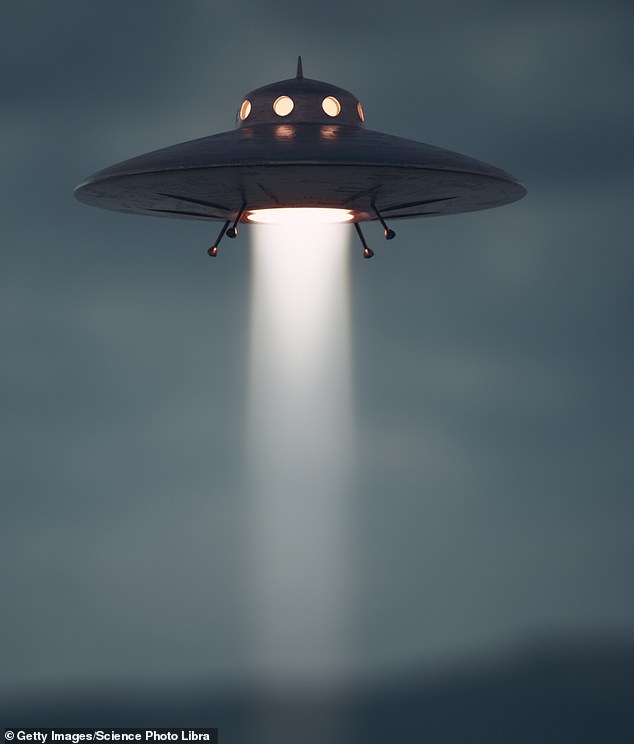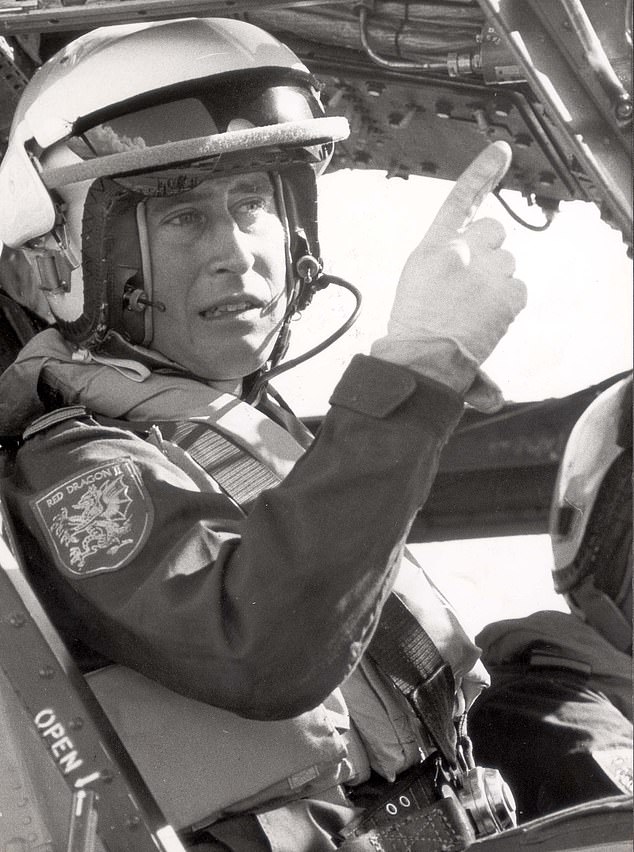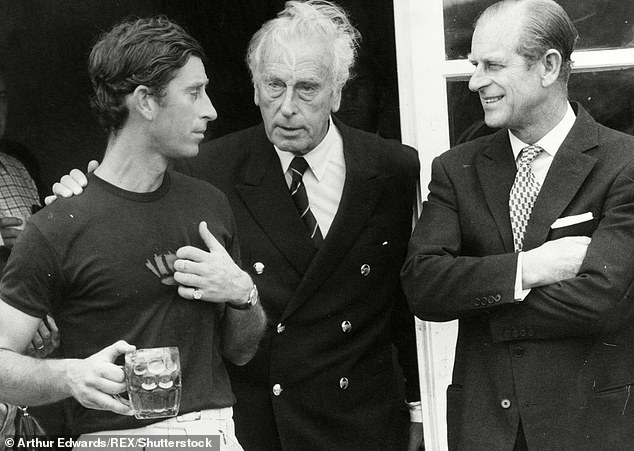How the Royals may know the truth about aliens: Expert DR DAVID CLARKE reveals why UFO experts were invited to the Palace… and the mysterious sealed files that might hold the answer
King Charles is known as a man of discerning tastes and strong opinions. He has a long-held interest in alternative beliefs and mystical therapies, and we all know his thoughts on leaky pens.
But who would have thought His Majesty may also have been a close associate of visitors from another planet and was once spotted at the controls of a UFO?
That is the bizarre claim being made in a new TV documentary which examines the royals’ interest in UFOs and other paranormal mysteries.
King Of UFOs, made by British musician and UFO buff Mark Christopher Lee and now available on Amazon Prime, asks the question: does the Royal Family know what’s really out there?
In it, he speaks to a diver, Dan Costello, who says he witnessed Charles, then Prince of Wales, at the controls of ‘a saucer-shaped craft with dual rotor blades’ at Sandy Point in Nova Scotia, Canada, in 1975.

The then dashing 27-year-old prince was one of three pilots spotted steering the ‘odd-looking’ object, while serving as a qualified helicopter pilot with the Royal Navy, he claims.
Describing the aircraft, he says: ‘It would sit and hover in the sky with the blades not on [rotating] with no sound of propulsion, just a faint crackle of electromagnetism.’
While, sadly, Costello goes on to admit that the aircraft Charles was allegedly flying was most probably not of alien origin, but part of a secret military operation, involving the British and Canadian governments – plus it hasn’t been confirmed that Charles was anywhere near Canada at the time – it does bring into focus a royal fascination with all things ‘other worldly’, that goes back generations.
Indeed, as I can exclusively reveal, the King may well have inherited a keen interest in the subject from his late father, Prince Philip, and his great-uncle, Lord Mountbatten, both of whom were avid enthusiasts.
Philip had a lifelong interest and curiosity in a range of fringe subjects, including UFOs, crop circles and the Loch Ness monster.
Mountbatten’s fascination, meanwhile, reached its zenith between 1950 and 1959, shortly before his appointment as Chief of Defence Staff, the highest position in the British military. And it prompts Lee, in the documentary, to ask of our new King: ‘Does he know the truth? If so, he should release this truth to the public.’
As an investigative journalist, university lecturer and committed ufologist, I first heard of the active role the royals had played in seeking the answer to the ultimate question – Are we alone? – as part of my research back in the early 2000s.
I was able to examine Mountbatten’s private papers at the Broadlands Archive, which prove he had a thing for space travel and avidly consumed the early literature on flying saucers, as UFOs were known at that time.


The term ‘flying saucer’ was first used in 1947 after pilot Kenneth Arnold reported seeing a chain of nine objects in the sky while flying over Washington State, describing them as flying at great speed and skipping like a ‘saucer on water’.
The world was gripped and, before long, saucers were being spotted everywhere.
In 1950, Mountbatten encouraged newspaper editor Charles Eade, who had served as his press secretary during the war in the Far East, to publish ‘all the available evidence’ in his paper, the Sunday Dispatch.
Eade wanted Mountbatten to allow his name to be used in his series as it would add to its credibility – but Mountbatten refused.
Instead, Eade’s front-page splash, under the headline ‘Flying saucers… the story that may be bigger than atom bomb wars’, was credited to a source whom he described as ‘one of the most famous men alive today’ who ‘commands universal respect and admiration’.
Mountbatten’s theory was that they were craft from other planets, as his letters to Eade reveal: ‘The available evidence shows they are not of human agency, that is to say they do not come from our Earth.
‘If that is so, then presumably they must come from some heavenly body, probably a planet. Maybe it is the Shackletons and Scotts of Venus or Mars who are making their first exploration of our Earth.’ This interest was shared by Charles and by Prince Philip, who was among the first subscribers to the magazine Flying Saucer Review, launched in London during 1955 and edited by retired RAF pilot Derek Dempster.
According to one of its later editors, Gordon Creighton, every copy was sent to Buckingham Palace.
In 2002 I was invited to tea by Mountbatten’s youngest daughter, Lady Pamela Hicks, now 95, at her stately home in Oxfordshire to discuss the subject.
She told me how her father was fond of asking, ‘Do you believe in flying saucers?’ as a conversation opener during visits to royal courts and capitals across Europe.
She described a lunch with the then King Idris of Libya, when her father was Commander-in-Chief of the Allied Forces in the Mediterranean. ‘After the usual pleasantries there was quite a long silence and my father decided to break it by asking [through an interpreter] what for him was the burning question, ‘Will you ask his majesty if he believes in flying saucers?’
‘There was this frightful pause, as the king thought his leg was being pulled. But when it was established that it was a genuine question, he said that of course he believed in them.
‘He said he had seen two of them himself and added that the Prophet recorded how a close companion of his had seen one of the fiery sphere types – as had his camel.’
Meanwhile, the Duke of Edinburgh’s voracious appetite for information on flying saucers was confirmed to me by RAF Air Marshal Sir Peter Horsley, who served as his equerry from 1952 to 1955.

When I spoke to him in 2001, the year he died, he revealed he’d been tasked by his employer with finding out as much as he could on the subject and was given carte blanche to read any reports and to interview fighter pilots who had reported seeing unusual phenomena in the sky.
He told me he had arranged, with the duke’s personal approval, for RAF Fighter Command to send copies of the latest sightings made by aircrew for examination at Buckingham Palace.
Perhaps the strangest outcome of this inquiry was Peter Horsley’s role in inviting several UFO witnesses to discuss their experiences at Buckingham Palace.
These included the captain of a BOAC airliner, James Howard, who witnessed, along with other crew members and passengers, a strange formation of UFOs while flying over the North Atlantic in June 1954.
Another visitor to the palace was schoolboy Stephen Darbishire who obtained two photographs of a ‘saucer’ hovering above the slopes of the Old Man of Coniston in the Lake District, in February of that year.
Horsley explained his reason for inviting UFO witnesses to the palace was partly to ‘put them on the spot’ and to test their honesty in the presence of royalty – a method as effective as any truth serum.
They both passed the test with flying colours, convincing their esteemed hosts – and Horsley himself – that Earth had indeed had visitations from outer space.
Horsley was scathing about a growing movement of cranks and fantasists, however, who he thought were making a mockery – and quite a bit of money – out of the flying saucer craze.
Among those Horsley accused of making a joke out of a very serious subject was the notorious Polish-American writer George Adamski, who co-authored the 1953 best-seller Flying Saucers Have Landed with Desmond Leslie, a former Second World War Spitfire pilot who had his own contacts in the British establishment.
Leslie was friends with General Sir Frederick ‘Boy’ Browning, the husband of author Daphne du Maurier. After retiring from the military, Browning had become head of Princess Elizabeth’s staff and, following her accession, worked for Prince Philip.
Browning was another member of what Horsley described as ‘the flying saucer club’ at the palace.
Adamski’s book contained his personal account of an alleged meeting with the Venusian pilot of a flying saucer ‘scout-ship’ that landed in the Mojave Desert of California, communicating with its angelic occupant by telepathy.
In April 1959, Adamski embarked on a European lecture tour that included an audience with the Dutch royal family – proving they too had caught the alien bug – and, shortly before he arrived in London, Leslie wrote to the Duke of Edinburgh, enclosing a personal invitation for them to meet Adamski, in secret if necessary.
Prince Philip clearly realised the public relations danger this could place him in as he annotated Leslie’s letter – now preserved in the Imperial War Museum archives – with the words, ‘Not on your Nellie!’, adding in a later note: ‘He may not be a crank but he’s a bit too fanciful for me!’
However, despite the royal disapproval, both General Browning and Peter Horsley met Leslie and Adamski during their visit at a private address in London.
Horsley told me he was not impressed by either. He felt that Desmond Leslie was ‘probably sincere but gullible, sucked into the saucer cult by people who hoped to profit from it, such as Adamski’ and he warned Browning against having any further contact with them.
Peter Horsley’s direct knowledge of the duke’s interest in UFOs and other strange phenomena ended when he left the palace in 1955 to return to RAF duties. Yet the royal fascination remained.
In 1978, Lord Mountbatten joined Prince Philip and the Queen at the star-spangled royal premiere of Steven Spielberg’s Hollywood blockbuster Close Encounters of the Third Kind at the Odeon in Leicester Square. The film tells the story of government conspiracy to hide the first arrival of UFOs and their friendly alien crews on Earth.
Over the decades the duke had maintained an active interest in a range of esoteric subjects.
During the 1960s, he became involved in plans for a full-scale investigation in search of the Loch Ness monster.
A Conservative MP, David James, persuaded him to use his connections with the Royal Navy to push for a publicly funded expedition to Loch Ness. The MoD’s Chief of Defence Staff, Sir Solly Zuckerman, raised the idea with the navy’s Chief Scientist, Sir John Caroll, arguing that ‘if a sonar investigation were to reveal something extraordinary in the loch, it would be of considerable scientific interest’. But Caroll blocked the idea, saying it would be too costly.
Royal interest in the arcane also extended to the crop circle phenomenon which, some argue, are created by extra-terrestrial life. One of the leading promoters of the mystery, Colin Andrews, sent a copy of his book Circular Evidence, co-written with Pat Delgado, to Queen Elizabeth.
In August of that year, The Times revealed that the book had been added to the Royal Family’s ‘holiday reading list’. Shortly afterwards, Andrews received a note from Buckingham Palace asking if he would provide updates ‘on the latest developments on the Circles Phenomenon’ for the Duke of Edinburgh, who had become a paid subscriber to his Crop Circles newsletter.
But the royals turned down Andrews’ offer to provide a personal briefing on the subject, perhaps having learned lessons from the duke’s earlier flirtation with George Adamski and his friends.
No one has been able to establish the full extent of the Duke of Edinburgh’s personal interest in UFOs and other strange phenomena as he never mentioned the subject in media interviews.
However, several contributors to the documentary, King Of UFOs, say that the Royal Archives at Windsor Castle include sealed files that are not to be opened until 90 years after his death – so more may yet be revealed.
In 2017, I wrote to Prince Philip to ask if correspondence on UFOs and crop circles had been preserved. I said there was considerable public interest in its contents, in particular the private study of the subject, completed on his behalf by Peter Horsley in 1955.
After a lengthy delay, Prince Philip’s private secretary, Brigadier Archie Miller-Bakewell, responded: ‘I am afraid that extensive searches have not yielded any papers that would be of help to your research. This letter comes with His Royal Highness’s best wishes.’
If he did know the truth, the duke – private, discreet and careful to the end – took it with him. But what about King Charles?


